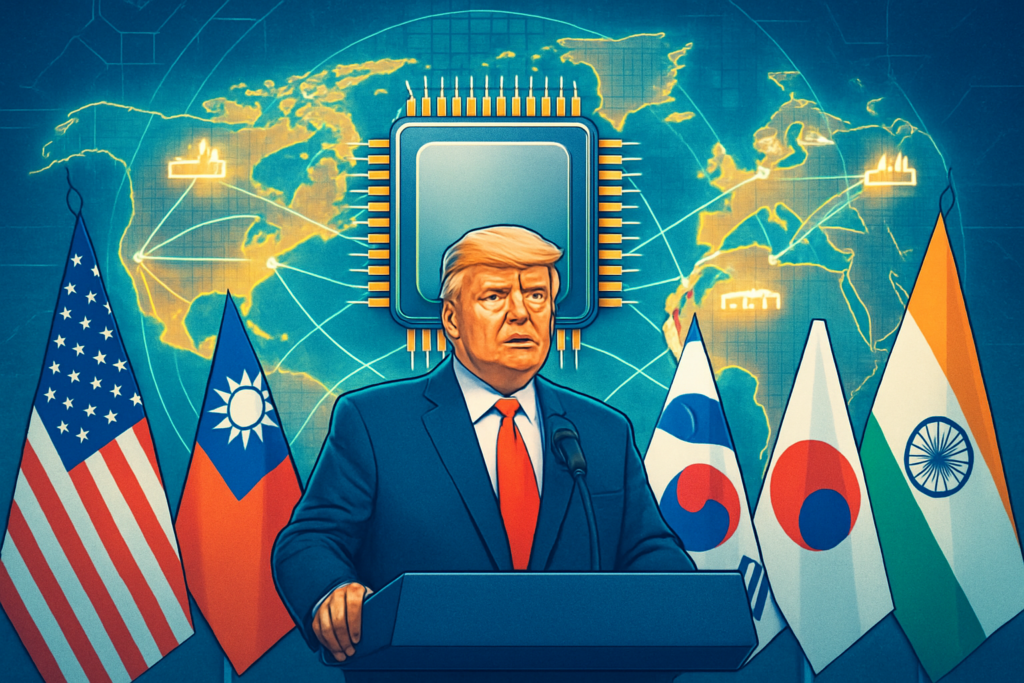
- Donald Trump has proposed a sweeping 100% import tariff on foreign semiconductors, a move aimed at reshoring chip production but with wide-reaching implications for global technology giants.
- Nearly 90% of the world’s most advanced chips are fabricated in Taiwan by TSMC, while South Korea dominates memory chip production through Samsung and SK Hynix.
- The proposed tariff could eventually boost onshore production, but, in the short term, may raise consumer prices, erode U.S. chip competitiveness, and disrupt innovation.
- Semiconductor diplomacy is no longer optional; it is central to geopolitical leverage.
Introduction
The global semiconductor supply chain is facing one of its most aggressive policy disruptions in recent memory. U.S. President Donald Trump has proposed a sweeping 100% import tariff on foreign semiconductors, a move aimed at reshoring chip production but with wide-reaching implications for global technology giants. This ‘silicon showdown’ could reshape supply chains, pressure U.S. tech companies, and create opportunities for countries like India amidst a reordering of the global tech map.
The Global Semiconductor Supply Web
In 2024, the U.S. imported over $46.3 billion worth of semiconductors. Nearly 90% of the world’s most advanced chips are fabricated in Taiwan by TSMC, while South Korea dominates memory chip production through Samsung and SK Hynix. China, although still behind in leading-edge fabrication, plays a significant role in assembly, testing, and subcomponent manufacturing. Moreover, China controls approximately 85 to 90 percent of the global rare-earth element refining capacity, which is essential for magnets, chip packaging, and other critical components.
Apple: Immense Scale, Strategic Manoeuvring
Apple spends over $67 billion annually on chips, representing 11% of global semiconductor demand. Over 157 of its top 187 suppliers have operations in China. Its A-series and M-series chips, powering iPhones and Macs respectively, are fabricated exclusively by TSMC in Taiwan. Memory is sourced from Samsung and SK Hynix in South Korea. Despite such dependencies, Apple secured an exemption from the proposed 100% tariff by pledging $600 billion in U.S. investments. These include co-investments in TSMC Arizona and Broadcom’s 5G chip operations.
Nvidia: AI Titan in Crosshairs
Nvidia is entirely fabless. It relies heavily on TSMC (Taiwan) and Samsung (South Korea) for the fabrication of high-performance GPUs such as the H100. In 2023, Nvidia was TSMC’s second-largest customer, contributing approximately $7.7 billion in revenue. A 100% tariff would effectively double the cost of Nvidia’s top chips. While it has not yet received a tariff exemption, Nvidia is reportedly exploring U.S. infrastructure investments to qualify.
AMD: The Underdog’s Challenge
Like Nvidia, AMD is fab-less and depends on TSMC for nearly all its processor production. Packaging is often handled by Chinese-owned facilities in Suzhou or Malaysian contractors. AMD lacks the profit margin buffer enjoyed by Nvidia and cannot easily absorb tariff-induced cost hikes. Worse, AMD competes directly with Intel, which operates major fabrication plants within the U.S. Without exemption, AMD could suffer market share losses.
Tariff Fallout: Industry Exceptions
The proposed tariff may achieve its long-term goal of driving onshore production, but in the short term, it risks a storm of consequences:
➔ Consumers could face higher prices for electronics, cars, and appliances.
➔ U.S. chip designers may lose competitiveness to foreign rivals.
➔ Supply chain uncertainties could stall innovation and product launches.
Assembly is slowly shifting to Vietnam, India, or Mexico, but fab capacity cannot be relocated overnight. High-end fabs take 3 to 5 years to build, cost billions, and require specialized talent.
Apple’s Advantage: Strategic Exemption
Apple secured a specialised exemption by pledging $100 billion in new U.S. investments. As a result, Apple can continue importing Taiwan-fabricated chips without penalty, sparing billions in potential costs. In contrast, smaller firms may struggle to avoid disruption. Apple’s success highlights how political capital and timely investment can offer a strategic edge in navigating protectionist trade regimes.
India: A Rising Contender
India is seizing this moment. The government has committed over INR 76,000 crore (~$10 billion) in chip subsidies. Foxconn, Pegatron, and Wistron are expanding their production of iPhones. Micron is investing $2.7 billion in Gujarat. Apple aims to produce 25% of iPhones in India by 2028. India’s neutral stance amid U.S.-China tensions and policy clarity makes it an ideal semiconductor alternative.
Conclusion: Silicon Diplomacy is the New Oil War
Trump’s tariff is more than an economic move. It forces global tech firms to rethink their dependencies and exposes weaknesses in U.S. industrial strategy. Apple’s exemption shows the value of influence. Nvidia and AMD remain vulnerable. For India, this is a defining opportunity to become a key global tech partner. Semiconductor diplomacy is no longer optional; it is central to geopolitical leverage.
The author is a Project & Program Management Consultant with expertise in strategy, planning, delivery and global deployments; and is deeply interested in geopolitics, defence, military affairs and foreign policies. Follow the author on X at @GeoBharatIntel. Views expressed are the author’s own.
